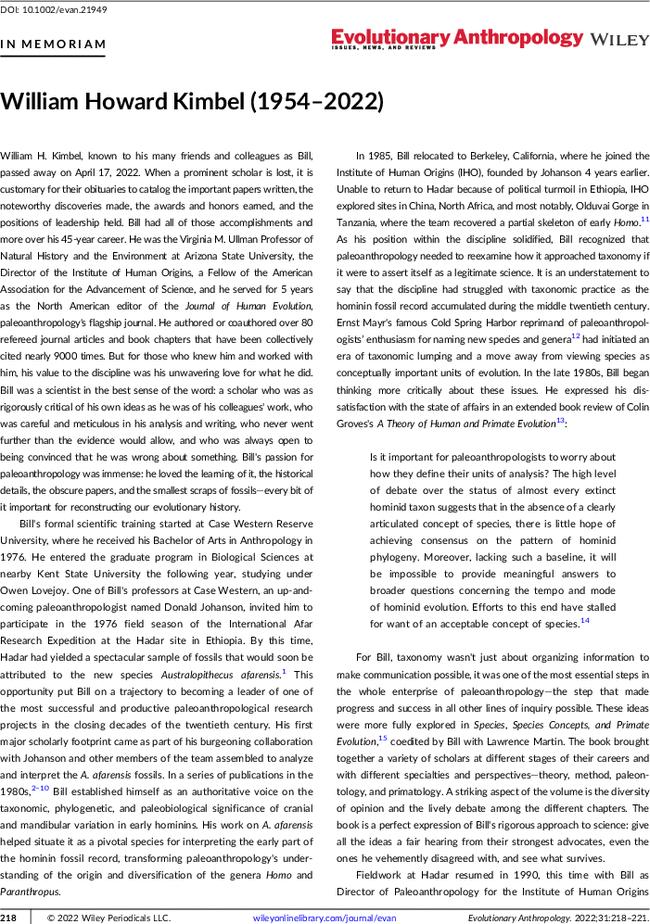William Howard Kimbel (1954–2022)
IF 3.1
2区 社会学
Q1 ANTHROPOLOGY
引用次数: 0
Abstract
William H. Kimbel, known to his many friends and colleagues as Bill, passed away on April 17, 2022. When a prominent scholar is lost, it is customary for their obituaries to catalog the important papers written, the noteworthy discoveries made, the awards and honors earned, and the positions of leadership held. Bill had all of those accomplishments and more over his 45‐year career. He was theVirginia M. Ullman Professor of Natural History and the Environment at Arizona State University, the Director of the Institute of Human Origins, a Fellow of the American Association for the Advancement of Science, and he served for 5 years as the North American editor of the Journal of Human Evolution, paleoanthropology's flagship journal. He authored or coauthored over 80 refereed journal articles and book chapters that have been collectively cited nearly 9000 times. But for those who knew him and worked with him, his value to the discipline was his unwavering love for what he did. Bill was a scientist in the best sense of the word: a scholar who was as rigorously critical of his own ideas as he was of his colleagues' work, who was careful and meticulous in his analysis and writing, who never went further than the evidence would allow, and who was always open to being convinced that he was wrong about something. Bill's passion for paleoanthropology was immense: he loved the learning of it, the historical details, the obscure papers, and the smallest scraps of fossils—every bit of it important for reconstructing our evolutionary history. Bill's formal scientific training started at Case Western Reserve University, where he received his Bachelor of Arts in Anthropology in 1976. He entered the graduate program in Biological Sciences at nearby Kent State University the following year, studying under Owen Lovejoy. One of Bill's professors at Case Western, an up‐and‐ coming paleoanthropologist named Donald Johanson, invited him to participate in the 1976 field season of the International Afar Research Expedition at the Hadar site in Ethiopia. By this time, Hadar had yielded a spectacular sample of fossils that would soon be attributed to the new species Australopithecus afarensis. This opportunity put Bill on a trajectory to becoming a leader of one of the most successful and productive paleoanthropological research projects in the closing decades of the twentieth century. His first major scholarly footprint came as part of his burgeoning collaboration with Johanson and other members of the team assembled to analyze and interpret the A. afarensis fossils. In a series of publications in the 1980s, Bill established himself as an authoritative voice on the taxonomic, phylogenetic, and paleobiological significance of cranial and mandibular variation in early hominins. His work on A. afarensis helped situate it as a pivotal species for interpreting the early part of the hominin fossil record, transforming paleoanthropology's understanding of the origin and diversification of the genera Homo and Paranthropus. In 1985, Bill relocated to Berkeley, California, where he joined the Institute of Human Origins (IHO), founded by Johanson 4 years earlier. Unable to return to Hadar because of political turmoil in Ethiopia, IHO explored sites in China, North Africa, and most notably, Olduvai Gorge in Tanzania, where the team recovered a partial skeleton of early Homo. As his position within the discipline solidified, Bill recognized that paleoanthropology needed to reexamine how it approached taxonomy if it were to assert itself as a legitimate science. It is an understatement to say that the discipline had struggled with taxonomic practice as the hominin fossil record accumulated during the middle twentieth century. Ernst Mayr's famous Cold Spring Harbor reprimand of paleoanthropologists’ enthusiasm for naming new species and genera had initiated an era of taxonomic lumping and a move away from viewing species as conceptually important units of evolution. In the late 1980s, Bill began thinking more critically about these issues. He expressed his dissatisfaction with the state of affairs in an extended book review of Colin Groves's A Theory of Human and Primate Evolution:

威廉·霍华德·金贝尔(1954-2022)。
本文章由计算机程序翻译,如有差异,请以英文原文为准。
求助全文
约1分钟内获得全文
求助全文
来源期刊

Evolutionary Anthropology
ANTHROPOLOGY-
CiteScore
7.00
自引率
5.40%
发文量
46
期刊介绍:
Evolutionary Anthropology is an authoritative review journal that focuses on issues of current interest in biological anthropology, paleoanthropology, archaeology, functional morphology, social biology, and bone biology — including dentition and osteology — as well as human biology, genetics, and ecology. In addition to lively, well-illustrated articles reviewing contemporary research efforts, this journal also publishes general news of relevant developments in the scientific, social, or political arenas. Reviews of noteworthy new books are also included, as are letters to the editor and listings of various conferences. The journal provides a valuable source of current information for classroom teaching and research activities in evolutionary anthropology.
 求助内容:
求助内容: 应助结果提醒方式:
应助结果提醒方式:


